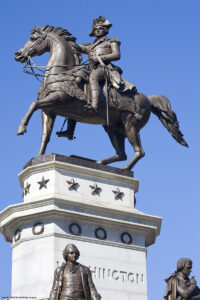
You may remember the 2017 tragedy in Charlottesville, Virginia, when an anti-racism protestor was killed by a white supremacist. That incident began over the city’s attempt to remove a statue of Confederate General Robert E. Lee. Afterwards, the country began to debate the role of controversial historical monuments in our public spaces. Hundreds of statues, plaques, and memorials celebrating questionable historical figures exist all across the nation; after the Charlottesville tragedy, many were removed or relocated to private spaces.

This debate is still going on today. In Richmond, Virginia–the historic capital city of the Confederacy. Several monuments to Confederate leaders remain. Now, a well-known artist named Kehinde Wiley (most famous for his official presidential portrait of Barack Obama has responded by creating his own statue. This one depicts a young black man with dreadlocks and wearing Nikes, riding a horse in the style inspired by the statue of Confederate General J.E.B. Stuart that stands a mile away. Wiley’s statue is called “Rumors of War,” and it is permanently installed in front of the Virginia Museum of Fine Arts. Based on what you’ve heard and seen in the news . . .
You Decide: What is the best response to controversial historical statues and memorials?
Keep Them
- These memorials recognize critical figures and events in our nation’s history. Removing them would be like ignoring or hiding a chapter of the past.
- Keeping the controversial memorials provides an opportunity for education. Some cities have elected to keep their statues and have added informational plaques to them, in order to provide historical context.
Remove Them
- People should not have to look at memorials based upon an offensive past as they go about their daily business. Similarly, public tax dollars should not be used to maintain and preserve such monuments.
- Offensive memorials would not have to be destroyed; rather, they can be relocated to private places such as museums, where people can choose to go and see them–and possibly learn more about the history of the events being presented.
Create Alternate Memorials
- Creating memorials to women and people of color allows us to recognize their importance as part of our complicated national story.
- Statues like Wiley’s remind us of the critical role that slavery and racism played in the Civil War–which can often be minimized when we celebrate Confederate leaders.
